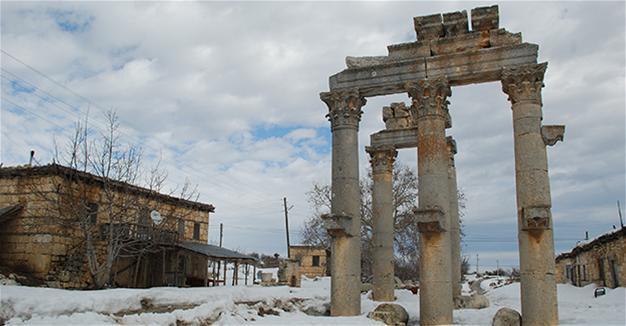Uzuncaburç: A visual feast in winter
MERSİN - Anadolu Agency

AA photo
The ancient city of Uzuncaburç (Olba), one of the most notable tourism attractions in the southern province of Mersin, is a draw for visitors even in the winter months when it acquires an extra beauty under a blanket of snow.
Located 30 kilometers from the center of the Silifke, Uzuncaburç is home to columns, temples, churches and monumental tombs that are thousands of year old. The city is also known for its resemblance to the ancient city of Ephesus in İzmir, earning it the moniker of the “Mediterranean Ephesus.”
Silifke Tourism Association Chairman Ali Küçük said the ancient city hosted thousands of local and foreign guests every year.
The ancient city is one of the most significant cities in the Cilicia region, Küçük said. “Uzuncaburç is mostly formed by temples as a center of religious worship. As Christianity expanded, these temples were converted into churches and used as places of worship by Christians living in the region. This place was added to the Ottoman [Empire] in the 16th century.”
Küçük said the region offered a historical journey to visitors with every step. “When traveling around Uzuncaburç, we see that it is as beautiful as Ephesus. We advise everyone visiting Silifke to come to this ancient city, too. It is more attractive in winter thanks to snowfall in winter months,” he said.
Uzuncaburç: The long bastion
Uzuncaburç, an important place of worship in the the Olba Kingdom during the Hellenistic age, was separated from Olba at the time of Emperor Vespasianus in the Roman era in 72 B.C. and turned into an autonomous site that could print its own money under the name Diocaesarea.
The Temple of Zeus, a mausoleum with a bastion and a pyramid roof are among the Hellenistic-era artifacts in Diocaesarea while the colonnaded street, theater, ceremonial arch, fountain and triumphal arch are among the Roman-era artifacts.
When Christianity began to grow in the region in the fifth century, the Temple of Zeus was converted into a church, while new churches were also constructed.
After the Turks began to displace the Byzantines following the Battle of Manzikert in 1071, the Turkish era began in the ancient city, which was dubbed “Uzuncaburç” (Long Bastion) in reference to a bastion that became the symbol of the city.
